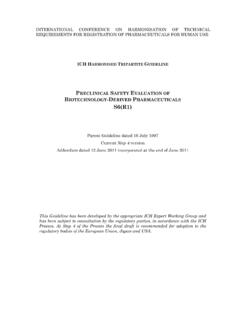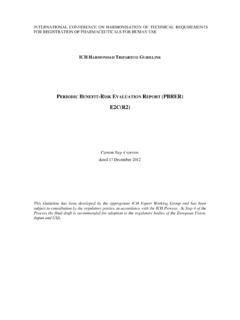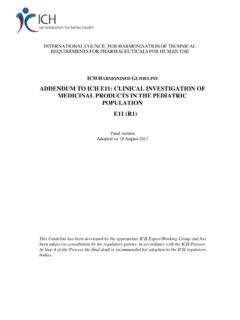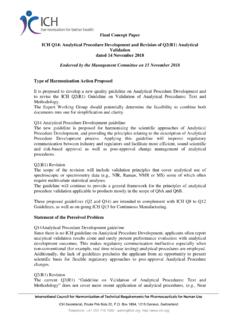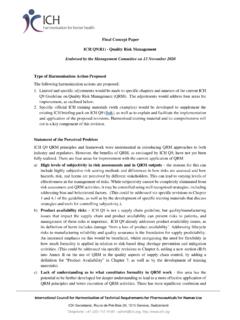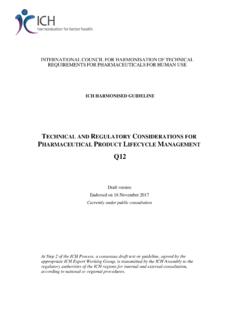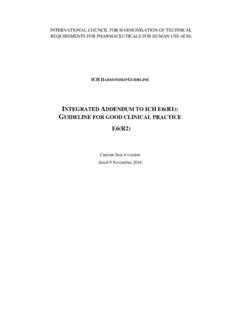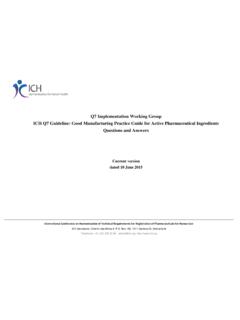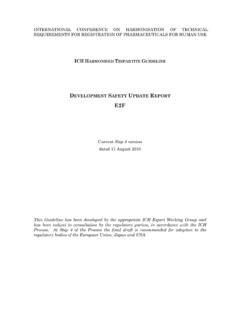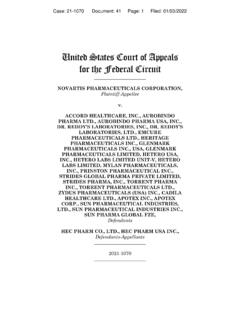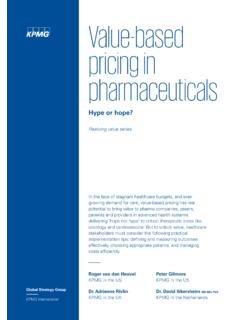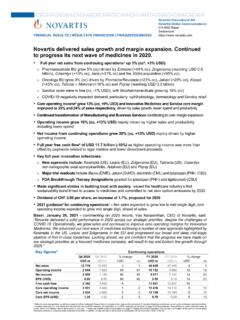Transcription of GUIDELINE FOR GOOD CLINICAL PRACTICE
1 INTERNATIONAL CONFERENCE ON HARMONISATION OF TECHNICAL REQUIREMENTS FOR REGISTRATION OF PHARMACEUTICALS FOR HUMAN USE ICH HARMONISED TRIPARTITE GUIDELINE SAFETY PHARMACOLOGY STUDIES FOR HUMAN PHARMACEUTICALS S7A Current Step 4 version dated 8 November 2000 This GUIDELINE has been developed by the appropriate ICH Expert Working Group and has been subject to consultation by the regulatory parties, in accordance with the ICH Process. At Step 4 of the Process the final draft is recommended for adoption to the regulatory bodies of the European Union, Japan and USA.
2 S7A Document History first Codification History Date New Codification November 2005 S7A Approval by the Steering Committee under Step 2 and release for public consultation. 2 March 2000 S7A Current Step 4 version S7A Approval by the Steering Committee under Step 4 and recommendation for adoption to the three ICH regulatory bodies. 8 November 2000 S7A SAFETY PHARMACOLOGY STUDIES FOR HUMAN PHARMACEUTICALS ICH Harmonised Tripartite GUIDELINE Having reached Step 4 of the ICH Process at the ICH Steering Committee meeting on 8 November 2000, this GUIDELINE is recommended for adoption to the three regulatory parties to ICH TABLE OF CONTENTS 1.
3 1 Objectives of the GUIDELINE .. 1 1 Scope of the 1 General 1 Definition of Safety 1 2. 2 Objectives of 2 General Considerations in Selection and Design of Safety Pharmacology 2 Test 2 General Considerations on Test 3 Use of In Vivo and In Vitro 3 Experimental 3 Sample Size and Use of 3 Route of 3 Dose Levels or Concentrations of Test 4 In Vivo 4 In Vitro 4 Duration of 4 Studies on Metabolites, Isomers and Finished 4 Safety Pharmacology Core 5 Central Nervous 5 Cardiovascular 5 Respiratory 5 i Statistical Principles for CLINICAL Trials Follow-up and Supplemental Safety Pharmacology Follow-up Studies For Safety Pharmacology Core Central Nervous Cardiovascular Respiratory Supplemental Safety Pharmacology Renal/Urinary Autonomic Nervous Gastrointestinal Other Organ Conditions under which Studies are not Timing of Safety Pharmacology Studies in
4 Relation to CLINICAL Studies Prior to first Administration in Studies During CLINICAL Studies Before Application of Good Laboratory PRACTICE (GLP)..7 3. 4. ii SAFETY PHARMACOLOGY STUDIES FOR HUMAN PHARMACEUTICALS 1. INTRODUCTION Objectives of the GUIDELINE This GUIDELINE was developed to help protect CLINICAL trial participants and patients receiving marketed products from potential adverse effects of pharmaceuticals, while avoiding unnecessary use of animals and other resources. This GUIDELINE provides a definition, general principles and recommendations for safety pharmacology studies.
5 Background Pharmacology studies have been performed worldwide for many years as part of the non- CLINICAL evaluation of pharmaceuticals for human use. There have been, however, no internationally accepted definitions, objectives or recommendations on the design and conduct of safety pharmacology studies. (Note 1) The term safety pharmacology studies first appeared in the ICH topics, Timing of Non- CLINICAL Safety Studies for the Conduct of Human CLINICAL Trials for Pharmaceuticals (M3) and Preclinical Safety Evaluation of Biotechnology-Derived Pharmaceuticals (S6) as studies that should be conducted to support use of therapeutics in humans (1, 2).
6 Details of the safety pharmacology studies, including their definition and objectives, were left for future discussion. Scope of the GUIDELINE This GUIDELINE generally applies to new chemical entities and biotechnology-derived products for human use. This GUIDELINE can be applied to marketed pharmaceuticals when appropriate ( , when adverse CLINICAL events, a new patient population, or a new route of administration raises concerns not previously addressed). General Principle It is important to adopt a rational approach when selecting and conducting safety pharmacology studies.
7 The specific studies that should be conducted and their design will vary based on the individual properties and intended uses of the pharmaceuticals. Scientifically valid methods should be used, and when there are internationally recognized methods that are applicable to pharmaceuticals, these are preferable. Moreover, the use of new technologies and methodologies in accordance with sound scientific principles is encouraged. Some safety pharmacology endpoints can be incorporated in the design of toxicology, kinetic, CLINICAL studies, etc.
8 , while in other cases these endpoints should be evaluated in specific safety pharmacology studies. Although adverse effects of a substance may be detectable at exposures that fall within the therapeutic range in appropriately designed safety pharmacology studies, they may not be evident from observations and measurements used to detect toxicity in conventional animal toxicity studies. Definition of Safety Pharmacology Pharmacology studies can be divided into three categories: primary pharmacodynamic, secondary pharmacodynamic and safety pharmacology studies.
9 For the purpose of this document, safety pharmacology studies are defined as those studies that investigate the potential undesirable pharmacodynamic effects of a substance on 1 Safety Pharmacology Studies for Human Pharmaceuticals physiological functions in relation to exposure in the therapeutic range and above. (See Note 2 for definitions of primary pharmacodynamic and secondary pharmacodynamic studies.) In some cases, information on the primary and secondary pharmacodynamic properties of the substance may contribute to the safety evaluation for potential adverse effect(s) in humans and should be considered along with the findings of safety pharmacology studies.
10 2. GUIDELINE Objectives of Studies The objectives of safety pharmacology studies are: 1) to identify undesirable pharmacodynamic properties of a substance that may have relevance to its human safety; 2) to evaluate adverse pharmacodynamic and/or pathophysiological effects of a substance observed in toxicology and/or CLINICAL studies; and 3) to investigate the mechanism of the adverse pharmacodynamic effects observed and/or suspected. The investigational plan to meet these objectives should be clearly identified and delineated.
![[ICH E2F] [EXAMPLE DSUR – PHASE III INVESTIGATIONAL …](/cache/preview/e/7/a/2/e/6/3/0/thumb-e7a2e63043c4463724e748eb98faa3a7.jpg)
